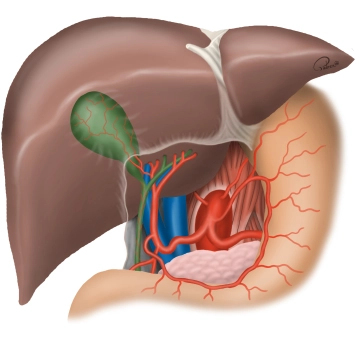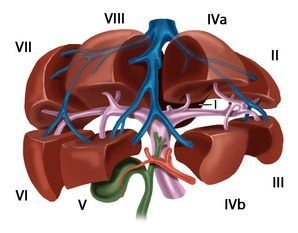The bile duct transports bile from the liver to the duodenum. In this way, bile contributes to the digestion of fatty foods. The bile ducts begin intrahepatically with the right and left hepatic ducts (D. hepaticus dexter et sinister), which descend from the liver. When they converge, these two ducts form the common hepatic duct. As this duct continues to the duodenum, it joins with the cystic duct, which comes from the gallbladder (Vesica biliaris). Together, they form the common bile duct, which opens into the duodenum. The major duodenal papilla (Vater's papilla) acts as a sphincter that regulates the flow of bile from the common bile duct into the duodenum.
-
General Anatomy
![General Anatomy]()
-
Special Anatomy
The arterial supply of the gallbladder occurs in 75% of cases via a single cystic artery, which branches from the right hepatic artery running dorsally to the right hepatic duct (see figure above). In the remaining cases, the cystic artery branches from other branches of the hepatic arteries or from the gastroduodenal artery and runs ventrally to the common hepatic duct, or multiple arterial branches lead to the gallbladder. If there is an unclear bleeding during the operation, it usually stops by compressing the hepatic artery in the hepatoduodenal ligament or after placing a vascular clamp supraduodenally (so-called Pringle maneuver). Persistent bleeding may indicate an accessory hepatic artery from the superior mesenteric artery!
Anomalies of the cystic duct are less common than vascular variations but are of greater importance regarding the risk of injuries to the common bile duct. The cystic duct can enter the bile duct system at any point, including the papilla. Accordingly, the length of the cystic duct varies, it can be very short or absent, spiral in front of or behind the common hepatic duct, or share a common wall with it (duplication of the common bile duct). Additionally, accessory bile ducts from the liver can enter the cystic duct, the gallbladder, or the right hepatic duct. If the cystic duct is not clearly visible, there is the possibility of opening the gallbladder and probing the duct from the inside. Alternative: in unclear situations, intraoperative cholangiography!
Injuries to the common bile duct result from anatomical anomalies or disease-related changes. Excessive traction on the cystic duct can lead to placing the resection clamp too deeply, so that the edge of the choledochus is captured and ligated! This then leads to transection or stenosis of the main bile duct.
-
Functional liver anatomy
![Functional liver anatomy]()
Through the falciform ligament and the insertion of the round ligament of the liver on the diaphragmatic as well as the sagittal fissure on the visceral surface, the liver is macroscopically divided into a larger right and a smaller left lobe (volume ratio approximately 80:20), although this morphological division does not correspond to the functional structure of the liver. The functional segmentation of the liver is determined by the branching of the portal structures: portal vein, hepatic artery, and bile duct. These three anatomical structures branch not only at the hepatic hilum but also predominantly in the same direction within the parenchyma. Each liver segment is completely independent in terms of blood supply and bile drainage from the other segments and can be surgically removed without endangering the function of the remaining liver.
The term "functional anatomy" thus refers to a sub-structuring of the liver, which is based on the delineation of hemodynamically independent parenchymal areas, and knowledge of which is essential for the surgical strategy in liver resection procedures.
The functional division of the liver is based on the portal branching into individual, independent
Activate now and continue learning straight away.
Single Access
Activation of this course for 3 days.
Most popular offer
webop - Savings Flex
Combine our learning modules flexibly and save up to 50%.
€44.50 / yearly payment
general and visceral surgery
Unlock all courses in this module.
€149.00 / yearly payment

